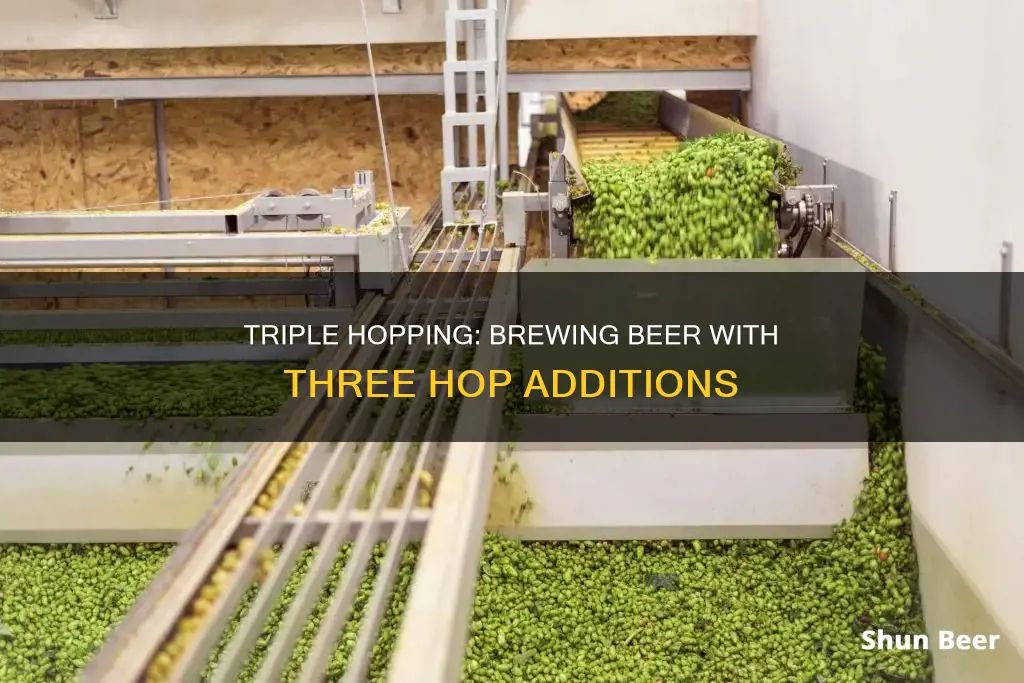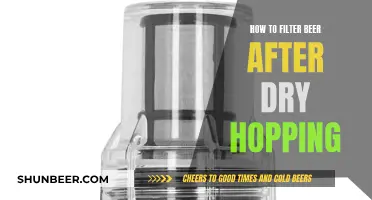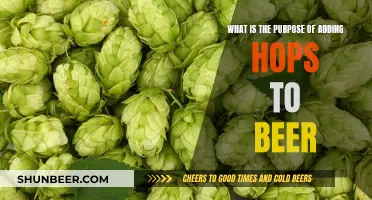
Triple-hopped beer is a term used in beer brewing to describe the addition of hops at three different stages of the brewing process. The specific stages at which the hops are added can vary, but typically they are added at the beginning, middle, and end of the wort boil. This technique is used to extract different characteristics from the hops, such as bitterness, flavour, and aroma. While some brewers may market their beer as triple-hopped to make it seem more unique or appealing, the reality is that most beers undergo multiple hop additions, and the term is not indicative of a specific style or flavour profile.
What You'll Learn

Triple-hopped beer is bitter
The second addition of hops typically occurs somewhere in the middle of the boil, with 30, 20, 15, or 10 minutes left. The third and final addition of hops is usually at the very end of the boil, with 5, 2, or 0 minutes remaining. After the final addition of hops, the wort is cooled down, and yeast is added.
The amount of bitterness in beer is measured in International Bittering Units (IBUs). A higher IBU value indicates a more bitter beer. For example, a true pilsner should have between 25 and 45 IBUs, while Miller Lite and Bud are typically in the 10-12 IBU range.
While triple-hopped beers will generally be more bitter than beers with fewer hop additions, other factors also influence the bitterness of the beer. The type of hops used, the length of the boil, and the alpha acid content of the hops can all affect the bitterness. Additionally, the presence of malt in the beer can balance out the bitterness and make the beer taste smoother and even sweeter.
Hops' Role in Brewing: Aromatic and Bitter Beer Balancing
You may want to see also

Hops are added at three stages
The wort is beer without the yeast in it. It is boiled, usually for 60 minutes. Hops are added at the beginning of the boil (60 minutes), somewhere in the middle (30, 20, 15, or 10 minutes left of the boil), and at the very end (5, 2, or 0 minutes). Then the wort is cooled down, and the yeast is pitched.
The hops added at the beginning of the boil are called bittering hops. This is the correct technical term. A calculation is used to determine the number of hops to add at this stage. The calculation is based on the alpha acid content of each hop, multiplied by the amount, multiplied by the time in the boil. This gives you the International Bittering Units (IBUs).
The hops added in the middle of the boil are called flavour hops. The beta acids in the hops are called "essential oils". They are volatile and quickly evaporate, providing the flavour to the beer.
The hops added at the end of the boil are called aroma hops. The aroma beta acids in the hops are the most volatile. Little to no bittering can occur at this point.
Growing Beer Hops Indoors: A Step-by-Step Guide
You may want to see also

Hops are added at the beginning, middle and end
Hops are added to beer at different stages of the brewing process to extract different flavour notes. When making a triple-hopped beer, hops are added at the beginning, middle, and end of the process.
The first addition of hops is made at the beginning of the boil, usually around 60 minutes before the end of the boil. This is done to extract the desired levels of bitterness, with the longer the boil, the greater the isomerization, and the more bitter the beer becomes. These hops are called the "bittering hops", and they form the base of the beer's flavour profile.
The second addition of hops is made somewhere in the middle of the boil, typically with 30, 20, 15, or 10 minutes left. This addition adds flavour to the beer, and the specific timing depends on the desired flavour intensity and the type of hops used.
The final addition of hops is made at the very end of the boil, often with just 5, 2, or 0 minutes remaining. This addition primarily contributes to the aroma of the beer, with minimal impact on bitterness. The volatile beta acids in the hops, which provide aroma and flavour, are highly sensitive to heat and prolonged boiling, so adding them at the end ensures their delicate characteristics are preserved.
By adding hops at these three distinct stages, brewers can create a complex and well-rounded flavour profile in their beer. The combination of bittering hops, flavour hops, and aroma hops results in a triple-hopped beer with a balanced blend of bitterness, flavour, and aroma.
Hops: Brewing Demand and Future Growth
You may want to see also

Hops are added to balance malt
Hops are added to beer to balance the malt's sweetness. Hops provide bitterness, flavours, and aromas to the beer. The hops used can have a range of flavours and aromas, from citrus and pine to earthy and spicy. The hops added to the wort at the end of the boil will retain more aromatics, lending to the piney, citrusy, herbal, or grassy notes that IPA lovers enjoy.
The hops added during the boil are called the bittering hops. The bitterness of the beer depends on the alpha acid content of the hops, the amount of hops used, and the length of time the hops were boiled. The hops added at the beginning of the boil (60 minutes), somewhere in the middle (30, 20, 15, or 10 minutes left), and at the very end (5, 2, or 0 minutes) are all part of the triple-hop process.
The key to great beers is to ensure a perfect balance between the malt and hops according to style. The malt provides the sugars that are fermented by the yeast to create alcohol and CO2. It is also the primary source of beer colour and significantly contributes to flavour and mouthfeel. The most common malted grain is barley malt, but others include wheat, rye, and oats.
Brewers must carefully select their malts and hops and formulate recipes that create a well-balanced beer with the desired flavour profile and drinkability. The balance between malt and hops is a delicate one, and brewers must pay close attention to the amounts and types of each ingredient to create a harmonious beer.
Micolob Beer's Hoppy Secret: What's Inside?
You may want to see also

Triple-hopped beer has a higher ABV
Triple-hopped beer does not inherently have a higher ABV. ABV, or alcohol by volume, is calculated by comparing the amount of sugar present in the beer at the start of fermentation to the amount remaining at the end. Higher ABV beers are achieved by using higher amounts of fermentable sugars in the recipe.
Triple-hopped beer refers to the process of adding hops to the wort at three different stages of the brewing process. Hops are typically added at the beginning of the boil for bittering, somewhere in the middle for flavour, and at the end for aroma.
While adding more hops can contribute to a more complex flavour profile, it does not directly impact the ABV. The ABV of a beer can be influenced by factors such as the amount of fermentable sugars in the recipe, the type of yeast, and the fermentation process.
However, it is worth noting that the perception of ABV can be influenced by the presence of hops. Hops can enhance the perception of alcohol warmth and contribute to a fuller body and richer mouthfeel. Additionally, the volatile oils and bittering compounds in hops can affect how the flavours and aromas of a beer are expressed, potentially making the alcoholic character more or less prominent.
In summary, while triple-hopped beer may have a more robust flavour profile due to the addition of extra hops, it does not necessarily have a higher ABV. The ABV of a beer is determined by various factors, primarily the amount of fermentable sugars and the fermentation process.
Zywicki Portor Beer: Hops or No Hops?
You may want to see also
Frequently asked questions
Triple-hopped means that hops are added to the beer three times during the brewing process. Hops are added at the beginning, middle, and end of the boil.
The timing of hop additions affects the flavour of the beer. Hops added at the beginning of the boil are primarily for bittering, hops added in the middle contribute to the flavour, and hops added at the end add aroma.
Hops provide balance to the beer and act as a natural preservative. They also contribute to the flavour, bitterness, and aroma of the beer.
Some examples of triple-hopped beers include Miller Lite, Piraat Triple Hop, and Pliny the Younger.







